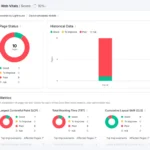
Introduction
Google’s search experience is evolving faster than ever — and Google AI Overview is at the center of this transformation.
Formerly known as the Search Generative Experience (SGE), this new AI-driven system changes how Google presents information. Instead of a list of blue links, users now see AI-generated summaries that pull information from multiple sources across the web.
If you want your brand or website to stay visible in this new AI-first world, you need to understand how to optimize your content for Google’s AI Overviews. This guide explains exactly what AI Overviews are, how they work, and how you can create content that stands out — even when AI is summarizing the web.
What Is Google AI Overview?
Google AI Overview is part of Google’s generative search technology that uses artificial intelligence to answer queries in a conversational, summarized way.
When users type a complex query — for example, “What are the best SEO tools for beginners?” — instead of listing links first, Google displays a brief, AI-generated summary with key points, sources, and sometimes follow-up prompts.
This summary is pulled from multiple web pages using natural language processing (NLP), semantic understanding, and entity recognition.
In other words, Google AI Overview doesn’t just show search results — it synthesizes them.
How Google AI Overview Works
Understanding how Google’s AI Overview selects and summarizes content is crucial. Here’s a simplified version of the process:
- Query Understanding: Google identifies user intent and context using AI models like MUM and Gemini.
- Content Selection: The system scans top-ranking, high-authority pages related to the topic.
- Information Extraction: It uses NLP to identify concise, factual, and well-structured content.
- AI Summary Generation: The AI produces an answer combining verified details from multiple sources.
- Source Attribution: Google often cites 3–5 sources within or below the AI overview.
Your goal as a content creator or SEO professional? Become one of those cited sources.
Why Google AI Overview Matters for SEO
Google AI Overview introduces a new SEO challenge — and opportunity.
While AI summaries may reduce clicks on generic content, being featured or cited in AI Overviews can drive massive visibility and brand authority.
Benefits include:
- Enhanced credibility (as Google’s AI “trusts” your content)
- Higher click-through rates from AI source links
- Increased topical authority and entity recognition
- More long-tail keyword coverage
As traditional SERP positions evolve, optimizing for Google AI Overview becomes essential for staying ahead.
How to Optimize Content for Google’s AI Overview
1. Write for Topics, Not Just Keywords
Google AI Overview focuses on understanding, not exact matches.
Cover your topic comprehensively — answer related sub-questions, include definitions, comparisons, and context.
Example:
Instead of just targeting “Google AI Overview,” also address:
- “What is Google’s AI search?”
- “How AI changes SEO rankings”
- “Tips to optimize for generative search results.”
This helps the AI recognize your page as contextually rich and authoritative.
2. Prioritize Factual and Verified Information
AI systems prefer data-driven, evidence-based content.
- Use statistics, case studies, and credible sources.
- Avoid speculation or outdated info.
- Keep facts current (especially for tech and SEO topics).
Google’s AI models reward accuracy and clarity, not fluff.
3. Optimize for Conversational Queries
Many AI Overview prompts are phrased as natural questions — e.g.,
- “How does Google AI Overview work?”
- “What are the benefits of AI search?”
Use headings and subheadings with conversational, long-tail questions. This improves your chances of being included in the AI-generated summary.
4. Improve Semantic and Entity SEO
Google’s AI understands entities — people, brands, products, and concepts — and their relationships.
To optimize:
- Include relevant entities naturally in your text.
- Add Schema Markup (FAQ, HowTo, Product, or Article schema).
- Link contextually to authoritative or related resources (like your article on SEO tools).
This helps Google’s AI associate your site with reliable information networks.
5. Use Clear Formatting and Scannable Layouts
AI models extract structured information more easily.
Use:
✅ Short paragraphs
✅ Bulleted lists
✅ Defined headers (H2, H3)
✅ Direct answers to questions
Clean, well-organized content increases your visibility in AI-driven search summaries.
6. Build Topical Authority
Don’t just publish one article on a trending topic — build a content cluster around it.
For example:
- Pillar Page: Google AI Overview: The Complete Guide
- Supporting Pages: How AI Search Changes SEO, Semantic SEO for AI Rankings, Core Web Vitals 2025.
Interlink them to establish topical authority. Google’s AI trusts sources that cover a niche comprehensively.
7. Optimize for User Experience
While AI drives discovery, user engagement still drives rankings.
- Improve Core Web Vitals (speed, stability, interactivity)
- Reduce bounce rates with better content flow
- Include visuals or explainer infographics
- Ensure mobile-first optimization
Remember, if users stay longer, Google’s AI learns your content is valuable.
8. Leverage Author Expertise (E-E-A-T)
Expertise, Experience, Authoritativeness, and Trustworthiness (E-E-A-T) are key signals for AI summarization.
Include:
- Author bios with credentials
- Citations from trusted sources
- Case studies or examples from real experience
AI Overview favors content from verified, credible voices.
Tools to Help You Optimize for AI Search
Here are a few SEO tools to analyze and enhance your content for AI Overview inclusion:
- Surfer SEO – identifies semantic gaps and readability improvements.
- Frase.io – compares your content against top AI-sourced competitors.
- Google Search Console – monitors performance in AI-generated search results.
- MarketMuse – helps build topical authority with entity analysis.
Conclusion
As Google AI Overview reshapes how search results appear, the key to visibility is clear:
Write content that helps users, not algorithms.
By focusing on semantic depth, structured formatting, factual accuracy, and E-E-A-T, you can increase your chances of being featured in AI-generated summaries — while building long-term authority.
In this new era of AI-powered search, your job isn’t to outsmart Google — it’s to collaborate with it by creating content that’s meaningful, trustworthy, and complete.
Visit our services – SEO services in hitechcity | SEO services in Surat | SEO company in Jaipur | SEO comapany in Lucknow| SEO company in Ameerpet
FAQs About Google AI Overview
1. What is Google AI Overview?
Google AI Overview is an AI-powered search feature that summarizes content from multiple web pages to provide users with quick, contextual answers.
2. How is Google AI Overview different from traditional search?
Traditional search lists pages; AI Overview summarizes them using generative AI, showing key points and linking to sources.
3. How can I make my content appear in Google AI Overview?
Focus on clarity, factual accuracy, topical depth, and structured formatting. Use semantic SEO and internal links (like to your SEO tools post) for context reinforcement.
4. Does Google AI Overview replace SEO?
No. SEO still matters. AI Overview simply changes how Google displays results. Optimized, high-quality content remains vital.
5. Are all types of content eligible for AI Overview?
Yes — blogs, guides, product reviews, and even videos can be cited if they provide valuable, verifiable information.





